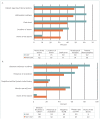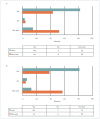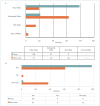Clinical Utility of the 31-Gene Expression Profile Test on the Management of Cutaneous Melanoma by Nurse Practitioners and Physician Assistants
- PMID: 38196667
- PMCID: PMC10715288
- DOI: 10.6004/jadpro.2023.14.7.3
Clinical Utility of the 31-Gene Expression Profile Test on the Management of Cutaneous Melanoma by Nurse Practitioners and Physician Assistants
Abstract
Objective: The 31-gene expression profile (31-GEP) can predict the risk of recurrence and metastasis in cutaneous melanoma (CM). We assessed the viewpoints and use of 31-GEP testing by physician assistants (PAs) and nurse practitioners (NPs) for patients with CM.
Methods: NPs and PAs (n = 369) completed an 18-question online survey about their viewpoints and use of the 31-GEP risk-stratification test.
Results: Most practitioners (n = 334, 90.5%) felt prognostic testing improved patient care and would recommend the 31-GEP to a colleague (n = 333, 90.2%) or a friend or family member (n = 289, 78.3%) who was diagnosed with CM. The 31-GEP test was used by 176 respondents in the preceding 12 months (53%). Among users of the 31-GEP test, 78% stated that the results would impact follow-up schedule and referral, 66% overall treatment decisions, 62% sentinel lymph node biopsy recommendations, and 50% surveillance imaging. In thin tumors (≤ 1 mm), 82% of 31-GEP users and 44% of nonusers stated that the 31-GEP results would impact their treatment plan decisions.
Conclusion: The 31-GEP test significantly impacts treatment plans in CM, particularly for thin and stage I melanomas. Importantly, even nonusers stated that 31-GEP test results would impact treatment plans as well as recommendations to a friend or family member.
© 2023 BroadcastMed LLC.
Conflict of interest statement
This study was funded by Castle Biosciences, Inc. Ms. Block has no conflicts of interest and nothing to declare. Ms. Patterson, Dr. Siegel, Dr. Martin, and Dr. Quick are employees, and stock and options holders at Castle Biosciences, Inc. Ms. Hunt is on the speakers bureau at Castle Biosciences, Inc.
Figures




Similar articles
-
Management Decisions Made by Physician Assistants and Nurse Practitioners in Cutaneous Malignant Melanoma Patients: Impact of a 31-Gene Expression Profile Test.J Drugs Dermatol. 2018 Nov 1;17(11):1220-1223. J Drugs Dermatol. 2018. PMID: 30500144
-
Expanded evidence that the 31-gene expression profile test provides clinical utility for melanoma management in a multicenter study.Curr Med Res Opin. 2022 Aug;38(8):1267-1274. doi: 10.1080/03007995.2022.2033560. Epub 2022 Feb 15. Curr Med Res Opin. 2022. PMID: 35081854
-
Attitudes of patients with cutaneous melanoma toward prognostic testing using the 31-gene expression profile test.Cancer Med. 2023 Jan;12(2):2008-2015. doi: 10.1002/cam4.5047. Epub 2022 Aug 1. Cancer Med. 2023. PMID: 35915969 Free PMC article.
-
Using Gene Expression Profiling to Personalize Skin Cancer Management.J Clin Aesthet Dermatol. 2022 Nov;15(11 Suppl 1):S3-S15. J Clin Aesthet Dermatol. 2022. PMID: 36405422 Free PMC article. Review.
-
Risk Stratification of Patients with Stage I Cutaneous Melanoma Using 31-Gene Expression Profiling.J Clin Aesthet Dermatol. 2021 Sep;14(9):E61-E63. J Clin Aesthet Dermatol. 2021. PMID: 34980974 Free PMC article. Review.
References
-
- Berger, A. C., Davidson, R. S., Poitras, J. K., Chabra, I., Hope, R., Brackeen, A.,… Miller, A. R. (2016). Clinical impact of a 31-gene expression profile test for cutaneous melanoma in 156 prospectively and consecutively tested patients. Current Medical Research and Opinion, 32(9), 1599–1604. 10.1080/03007995.2016.1192997 - DOI - PubMed
LinkOut - more resources
Full Text Sources
